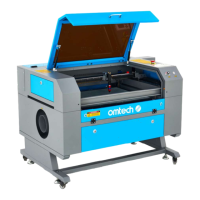22
Ceramics
When engraving on ceramics, generally use moderate to high power. Using more loops rather than higher power
and lower speed can help avoid cracking the material during work. Be mindful of the health risk posed by dust
generated from ceramic engraving, especially for repetitive industrial applications. Depending on the material
and the amount of work, a fan or even full ventilation system may be required to address the problem. Similarly,
operators and others in the work area may need to use breathing PPE such as masks and respirators.
Glass
When engraving glass, generally use high power and low speed. As with ceramics, it can be helpful to run more
loops at lower settings to avoid cracks. Care must be taken when engraving fi berglass and carbon fi ber to avoid
combinations of settings that produce a laser intensity great enough to damage the structural integrity of its
component fi bers, producing blurry marking. PPE should be worn to avoid exposure of the eyes, nose, mouth, and
skin to the dust produced by working with either material, especially for repetitive industrial applications. Clothing
worn while working with fi berglass should be washed separately afterwards.
Leather
When engraving leather products, generally use low to moderate power at high speed. Natural leather should be
engraved slightly slower and at slightly higher power than artifi cial leather. Be especially attentive to the possibility
of fi re, as well as the dust produced in repetitive applications.
Metal
CO₂ laser engravers should not be used for marking, engraving, or cutting metal. They are best suited for working
coatings applied to a metal base, and care must be taken not to attempt work on the underlying metal itself. A
variety of coatings specialized for CO₂ engraving are available, and the user should follow the instructions provided
as the parameters vary from product to product and metal to metal. Generally, work on aluminum coatings should
be done more quickly at lower power and work on steel coatings can be done more slowly at higher power.
Paper and Cardboard
When engraving various paper products, generally use low to moderate power and fast speed. Test samples from
each batch, as only small parameter diff erences can separate eff ects that are too light from those that burn through
the substrate. As with leather, be especially attentive of the possibility of fire, as well as the dust produced in
repetitive applications.
Plastics
Plastics for engraving are available in many diff erent colors and thicknesses and with many diff erent coatings and
surfaces. The majority of available plastics can be well engraved and cut with the laser. Plastics with a microporous
surface seem to give the best result, because less surface material needs to be removed. When engraving plastics,
generally use low power and high speed settings. Marking and engraving with too much power or at too low a
speed can concentrate too much energy at the point of contact, causing the plastic to melt. Among other problems,
this may produce poor engraving quality, noxious fumes, and even fi res. High resolution engraving can cause the
Average Cutting Settings for Artifi cial Leather
Description 1/16 in. 1/8 in. 1/4 in. 1/2 in. 3/4 in. 1 in.
80 W
Speed 25 mm/s 18 mm/s 6 mm/s 4 mm/s N/A N/A
Power 18% 28% 32% 40% N/A N/A

